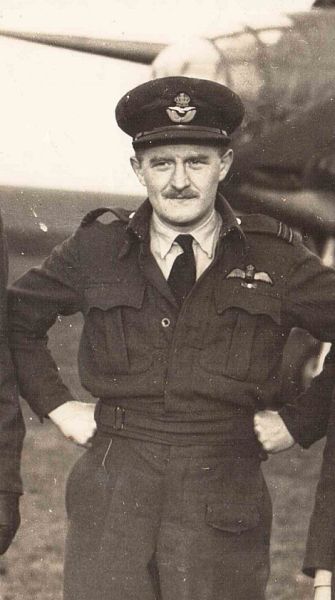Kennedy, Joseph Shaw
- Date of birth:
- 1914
- Date of death:
- November 17th, 1971
- Service number:
- 745508/81351
- Nationality:
- British
Biography
Joe Kennedy joined the Royal Air Force in 1939. He eared the dubious honor ‘The lowest flier in the R.A.F, when on 16 July 1941 a tree top lodged in his aircraft during a low-level attack on the docks and shipping at Rotterdam.
Later, on 19 July 1942, Kennedy successfully bombed a large textile factory on the northern outskirts of Lille, and set course for base flying at treetop height. Near St. Pol he was caught in a withering cross-fire between two German flak emplacements. After the port engine was knocked out he was forced to fly under some high tension cables, or rather through them, sustaining further damage to his aircraft. He managed to bring back the plane and it's crew safely to base. A portion of high-tension cable was extracted from the port engine, during the ground examination. Part of the cable was fashioned into a napkin ring for the Kennedy’s daughter, Jane, and remains a treasured family possession.
A year later he added a bar to his D.F.C. for his leadership and courage in the laying of an effective smoke screen for the ill-fated Dieppe raid on the 19 August 1942. Considerable flak was encountered and Kennedy’s aircraft was continually hit. Reduced to flying on one engine, his air-gunner George Casey wounded in both thighs but maintaining fire regardless, his passenger Flight Lieutenant McWilliam, mortally wounded, he led his formation long enough to successfully lay the smoke screen before limping to Shoreham for a crash-landing.
In December 1942, Kennedy was send to Canada to as Armament Chief Instructor, No. 31 Bombing and Gunnery School, Picton, Ontario.
The remaining months of the war he was appointed C.O. Khartoum.
After the war, Kennedy commanded Turnhouse, Shepherd’s Grove and Bentwaters and was S.A.S.O. for 65 Group, before becoming Air Attaché, Bucharest, in April 1954. This near three year tour behind the Iron Curtain appears to have had more than its fair share of excitement.
It is now common knowledge that diplomats of all sides were given instructions to keep their ears and eyes open, at the very least, and as such were virtually espionage agents. It would appear that Kennedy’s appointment was no different. At one time the K.G.B. abducted him and caused him great discomfort but fortunately he managed to escape their clutches.
In April 1959, Kennedy was forced to retire from the R.A.F. on medical grounds, and on 17 November 1971 he died aged just 57.
Promotions:
June 29th, 1940: Pilot Officer (probation)
June 29th, 1941: Flying Officer (war sub)
October 23th, 1941: Flight Lieutenant (war sub)
September 10th, 1943: Squadron Leader (war sub)
Do you have more information about this person? Inform us!
- Period:
- Second World War (1939-1945)
- Rank:
- Acting Squadron Leader
- Unit:
- No. 226 Squadron, Royal Air Force
- Awarded on:
- September 23rd, 1941
After bombing he attacked gun emplacements on the coast with machine gun fire. In an attack on shipping in July, 1941, Squadron Leader Kennedy, flying at a height of only 50 feet, bombed and destroyed an 8,000 ton merchant vessel. In August 1941, he participated in an attack on enemy shipping off the Dutch coast. In the face of intense anti-aircraft fire, he pressed home his attack from a bout 50 feet and destroyed a 4,000 ton merchant vessel. Squadron LeaderKennedy has displayed great leadership, courage and devotion to duty.’
- Period:
- Second World War (1939-1945)
- Rank:
- Acting Squadron Leader
- Unit:
- No. 226 Squadron, Royal Air Force
- Awarded on:
- September 18th, 1942
- Awarded for:
- Operation Jubilee
Flying Officer Casey was wounded in both thighs, while his co-gunner was critically injured. In spite of this, Squadron Leader Kennedy, resolutely supported by the skilful navigation of Flying Office Asker, led his formation over the town at low level and released his smoke bombswith precise accuracy on the target. Meanwhile, Flying Officer Casey, disregarding his injuries, engaged the enemy’s defences wherever they came within reach of his guns. Squadron Leader Kennedy eventually flew his damaged aircraft to base and landed safely. This officer, gallantly supported by Flying Officers Asker and Casey, displayed great courage, skill and determination."
Second DFC awarded as a bar for on the ribbon of the first DFC.
- Period:
- Second World War (1939-1945)
- Period:
- Second World War (1939-1945)
- Period:
- Second World War (1939-1945)
- Period:
- Second World War (1939-1945)
- Period:
- Second World War (1939-1945)
- Awarded on:
- March 6th, 1947
Sources
- Photo 1: Chris Brooks
- - The London Gazette Issue 35283 published on the 23 September 1941
- Second Supplement to The London Gazette Issue 35709 published on the 15 September 1942
- Supplement to The London Gazette Issue 35729 published on the 2 October 1942
- Morton and Eden









